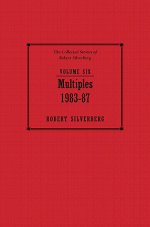
| The Collected Stories of Robert Silverberg: Volume 6, Multiples, 1983-1987 | |||||||
| Robert Silverberg | |||||||
| Subterranean Press, 432 pages | |||||||
|
A review by D. Douglas Fratz
This sixth volume covers the mid-1980s, a very productive period in Silverberg's career. These works show a
mature science fiction writer at the top of his craft. It is important to understand that this series is not
the complete stories of Robert Silverberg -- which would have been of unmanageable size -- but most of his
short fiction work from this five-year period is included here, and all fourteen stories are of amazingly
high quality. In this post-initial-Lord-Valentine-novels period, Silverberg was not an innovator per se,
but these stories demonstrate his mastery of using the existing themes and tropes of science fiction to invoke
profound emotion and intellectual effects. Although the stories vary greatly in their length, setting and
tone, there are many themes and tropes recurring across stories.
One of the tropes seen in several stories is tourism -- being a stranger in a strange land. "Tourists" is an
evocative story set in a near-future Morocco about alien tourists who visit Earth to obtain unique human art
and antiquities. "Sailing to Byzantium" is a brilliant novella about far-future tourists (and one 20th-century
man accompanying them) visiting fully recreated cities of the ancient world. "Blindsight" -- which was later
incorporated into the novel Hot Sky at Midnight -- is set on a future independent L5 colony that serves
as a haven for various legal refugees, and involves a local guide (called a courier) hired by a strange visitor
who has no eyes but can see nonetheless, and is seeking someone hiding there. "Gilgamesh in the Outback" is
another brilliant novella written in homage to Robert E. Howard's fantasy adventure fiction, with a setting
similar to Philip José Farmer's Riverworld, and protagonists that include REH himself,
as well as H.P. Lovecraft, and a variety of other reborn characters, including Gilgamesh, Prestor John,
Kubla Khan and Albert Schweitzer.
Another recurring trope is minds sharing a single body. In the thoughtful and emotionally evocative title
story, "Multiples", multiple personality "disorder" is normal, and indeed a desired state, creating an effective
metaphor for the loneliness experienced by socially isolated individuals. In "Symbiont" the experience of
having another being -- in this case an amoral alien one -- inhabiting one's mind and body is far less
copacetic in this dark future of interplanetary war that reminds of Joe Haldeman's The Forever War. But
perhaps the best of the sharing-minds stories is the brilliant novella "The Secret Sharer" -- written in
homage to the classic tale of nautical intrigue by Joseph Conrad -- which concerns the rogue-stored mind of
a young teenage passenger seeking refuge within the mind of the young male starship captain. The characters
face moral choices similar to those seen in the classic 50s science fiction story, "The Cold Equations" by Tom Godwin.
Another common trope is inexplicable aliens. In addition to "Tourist Trade" and "Symbiont" noted
above, "Against Babylon" (also later included in The Alien Years) is a story about aliens hovering above
Los Angeles where they inadvertently are creating brush fires, told from the viewpoint of one of the pilots
involved in fighting the fires, and the desire of his young wife to accompany the aliens. "Sunrise on Pluto"
is a short story on the discovery of apparent life on that planet, used as a springboard for considering the
nature and implications of life. In "Hardware" the alien is an ancient artificial intelligence found in the
asteroid belt that is left over from the destruction of Sol's ancient fifth planet. "Hannibal's Elephants" (again
later incorporated into the underappreciated novel The Alien Years) tells the dark, sardonic story of
aliens landing in Manhattan's Central Park, and the strange reactions it causes on residents of that
city. In "The Pardoner's Tale" (again part of The Alien Years), Silverberg's self-described "cyberpunk"
story, the aliens in Los Angeles (and other cities) have forced humans to build literal walls around the
city and a clever human hacker is in the illegal business of selling "pardons" so individuals can escape.
A final common theme in this period is morality and difficult moral choices. In addition to several stories
noted above, "The Iron Star" involves two human starships investigating the site of recent supernovae that
have formed a neutron star orbiting a black hole, and the revealing story learned from an alien ship that
also arrives that evokes difficult moral issues. The final story in the volume is the
brilliant "House of Bones" about a time-traveling anthropologist marooned among a prehistoric ice age tribe
in which he must be accepted to survive while awaiting rescue.
Virtually all of the stories included in this volume were amongst the best science fiction written in
the mid-1980s, and many were indeed nominated and/or won various awards. Robert Silverberg has created here
tales of emotional impact and intellectual depth that should be avidly perused by every serious science
fiction reader. I look forward to future volumes in the series.
D. Douglas Fratz has more than forty years experience as editor and publisher of literary review magazines in the science fiction and fantasy field, and author of commentary and critiques on science fiction and fantasy literature and media. |
||||||
|
|
If you find any errors, typos or anything else worth mentioning,
please send it to editor@sfsite.com.
Copyright © 1996-2014 SF Site All Rights Reserved Worldwide
